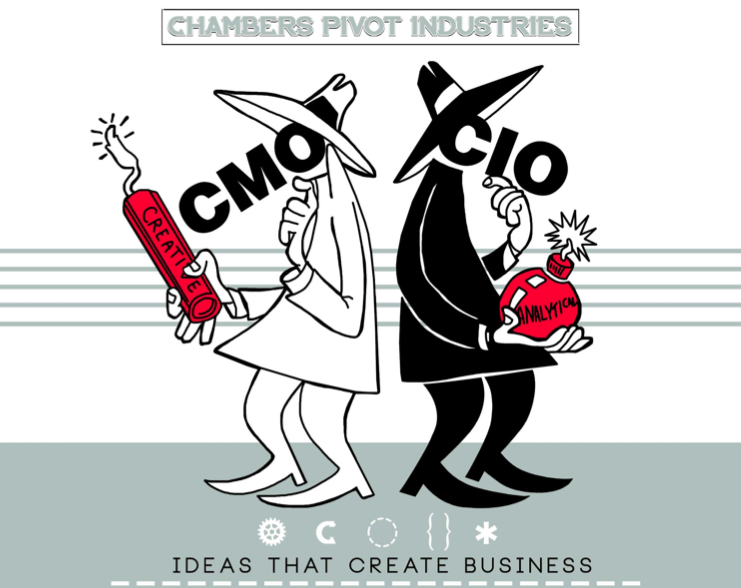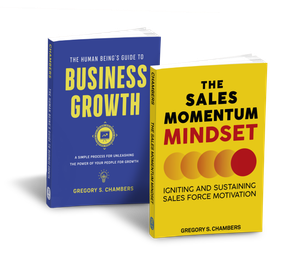Getting The CIO and CMO to Play Nice in the Era of Big Data
Getting The CIO and CMO to Play Nice in the Era of Big Data

This is a re-recording of a presentation I did at the Infotec technology conference in the spring of 2013.
3 communication tools that both parties can use to be more effective when communicating with one another. The transcript is below the video if you want to scan the contents. The video is just over 30 minutes long.
[expand title="Transcript" tag="strong"]
In the next 40 minutes I’m going to help with tools that will help your organization take advantage of the continued blurring of business roles coming from technology.
Before we get started, I’m going to bring up a semi-related communications problem. My daughter, the young Abby Chambers, is a Junior in College. Many years ago she was a Sesame Street loving toddler that attended daycare. One night, I was jolted awake as she called out from her room “Big Bird!”
Being child 1, and not having honed my middle of the night child duty skills, I jumped up and thought “Big Bird. Nightmare. Calm her. Back in 5.”
In the short distance between my room and hers, the “Calm her.” became “keep the lights off.”
I stumbled in, moved toward the bed cooing my soothing “It’s alright baby - just a nightmare - Daddy’s here”
I heard another “Big Bird” as I sat down on the edge of the bed. . . and SPLAT.
Not Big Bird. Turns out it was Big Burp.
A miscommunication. Abby and I are much better at communicating now, but it’s not easy.
We’re not going to be covering boy girl or even father daughter communication skills. That said, we’re going to be dealing with the next thorniest communication challenge: Analytical vs Creative. And we’re not going to get into all the left brain, right brain, analytical creativity and creative analysis stuff. . .let the academics fight over that. . .we’re going to focus on some tools that will help you communicate. 3 tools.
High level overview on why I’m here. . .
The marketing people are finding success in what is labeled BIG DATA. Big Data - all data - tends to reside in the IT department. It’s a classic stereotype, it’s right brain vs left brain, creative vs analytical. Check out these Dilberts and note the time stamp from the blogs that published them. 2009. 2007. This marketing vs IT issue is old and won’t be solved in 30 minutes. . .but if your job is to work with your “opposite”, these tools will help.
One thing I’m not going to go into the virtues of big data or whether or not a CIO or CMO should lead the process on vendor selection or consulting project or any other turf battles that will be coming your way. Just know that the sales guys are lurking and they’re exploring any chinks in your communication armor. . .
What I am going to do is give you some tools - some playground rules - that will aid in effective communication between these two worlds. Tools that will help CIOs and CMOs to Play Nice. As we roll through these 3 tools, I’ll include some real considerations and talk about their practical applications for you.
The best part? Even if your compatriot (CIO or CMO) isn’t part of this talk, you will be able to use these tools and be effective.
Does that sound about right? Is that what you’re expecting? Real tools to help these two departments, these two communication styles to PLAY NICE?
A little about me and why I’m up here. My background is not in IT. That said, I’ve run a few businesses - among them a computer training company - and I’ve learned enough about the role to be dangerous. My background is not marketing. Again, that said, I have worked closely with and employed many marketers and know enough about that role to be be potentially lethal.
My background is in sales. Specifically selling to CIOs and CMOs. Since I’m the customer facing guy, I’m in a unique position to give you some of my “secrets” for effective communication. I’ll be doing this in 3 parts.
Before I jump into these tools, lets set some common ground on why there is a need for them.
From the CIO perspective: the CIO - used to be the MIS director, used to be the DP Manager. Your role has always been evolving. Right now the change is cloud based technology the presents the big opportunity/threat. Your budgets are shifting once again and you’re seeing technology decisions being made in all areas and levels of the organization. . .rapid prototyping creative centers and such. . . but - when everything tech related comes crashing or is breached, who gets the call? Right. You and your team need these tools to help manage this change.
From the CMO perspective: the CMO? you were in Advertising, before that in a creative director and now it’s a C level position? Those are changes too. The C level gang is convinced you can measure everything. You were the creative/branding expert and now you need to add in financial savvy, leadership savvy, and a RESULTS focus like never before. You and your team need these communication tools to be more effective.
For both parties, the technology is putting us closer to the customer than ever before. I think these was another breakout that addressed this very subject. Put the customer first or something. Mobile devices, social media, cloud computing - LOTS OF DATA means data-driven decisions are not only possible but expected.
Everyone’s excited but the CIO is SO rigid and the CMO is SO flaky (yes - of stereotyping because it lets me paint with broad brush strokes) How can these two skill sets get along?
These tools! That’s how.
My 3 tools for - 3 playground rules - for PLAYING NICE:
We’re going to cover: The Definition of Terms
The Law of Reciprocity
The BL
3 tools that will improve communication between the CIO and CMO roles.
Let’s start at the top: The Definition of Terms
The beginning of wisdom is the definition of terms. That’s Socrates.
You’ve seen this picture, right? Or one like it? Big beautiful photoshopped iceberg. When it comes to communication, I’m going to borrow this analogy from my friend Mahan Khalsa. As we communicate with one another, that tip of the iceberg sticking out of the water represents the words and gestures and inflection the we use to get our point across. . .but what we mean is so much deeper. All that meaning is buried beneath the surface.
This is the iceberg effect of communication.
I’ll pick a word for you: Budget. We all know what this means right? The proforma. P & L. Projections. Everyone is on the same page.
Going a little deeper, when I talk about budgets, I have two approaches to a budget. Do you? My CIO self takes the budget and thinks in terms of TCO. Total Cost of Ownership. So, to operate this business with a $1MM technology line, I want to get the biggest bang for my buck, right? I manage that cost.
My CMO self takes that same budget and thinks in terms of ROI. Return on Investment. To operate this business with a $1MM marketing line, it needs to drive $10MM in top line sales. So, if I can find tools with a greater than 10 to 1 ROI, I’m going to spend accordingly. . . even if that means I need to invest $1.5MM.
BUDGET - same word (tip of the iceberg) - but two different meanings below the surface. Both valid, and both very important to the success of the business.
This is TOOL #1 - the definition of terms. Making sure we’re talking about roughly the same thing. I ask the CIO what the budget is, she tells me, and we fit the solution in. I ask the CMO, get a ballpark # and work on defining the ROI.
The technology sales people of the world are trying to get into the CMOs budget. No judgement there. The CMO can use the CIOs total cost of ownership tools and the CIO can use the CMOs ROI tools. It all starts with defining terms like budget.
Another way of saying this, Walk a mile in their shoes. Or maybe See it through their eyes.
Here’s another example: Big Data
I throw it out but that’s the tip of the iceberg, right? What is the CMO thinking when I say it? What about the CIO? Let’s explore that a big.
Still broad generalizations - the CIO hears big data and gets excited to structure the data, apply analytics, use new processes and methods to shape the data, and create new products.
The CMO thinks about customer loyalty, hyper personalization, and blending experiences across devices.
Similar but not the same thing right?
The more you know about what each party is really saying, the more effective your time together can be.
You’re thinking, really? How can I worry about defining all the terms we toss around? That would take forever! I agree. To break down the meaning of “is” to one another is probably saved for depositions but it’s not hard to listen for some key terms and bring up definitions.
CMO says “customer focused”, you can say, “Just to make sure we’re on the same page, when you say customer focused, which customers are you thinking about?”
CIO says “secure”, you can say, “I want to make sure I’m talking about the same thing you are, when you say secure, what do you mean?”
These aren’t always related to terms you’re both using - sometimes it’s a term that’s used by one party. Like CPA. You ask the CMO what he means, he says Cost Per Acquisition and you think “well, how are you getting that figure?” Or APP. You ask the CIO what she means, she says a program that serves a business purpose and you think “on a phone, right?”
Taking the first step and searching for understanding makes all the difference between haphazard communication and direction and a streamlined approach. Right? The good book says - seek first to understand. It requires setting your ego aside for a moment, but you can do it.
“Just to make sure we’re on the same page. . .”
“I want to double check that I understand. . “
“Tell me what you mean when you say . . .”
That’s where we start - defining terms. It’s an incredibly effective communication tool . . . sayeth Einstein: If I had one hour to solve a problem, I’d spend 55 minutes defining it”
Socrates, Einstein, Chambers - that’s strong evidence of the power of Defining Terms.
Once you’re on the same page, you need to use the 2nd most powerful tool in this communications arsenal - the law of reciprocity. I’m a huge fan of Dr Robert Cialdini and his studies of Influence. To paraphrase the work, reciprocity is a social construct that we have evolved as a society - trading favors is the best way to paraphrase it. Before we go drifting into the concept of FAVORS, know that in my definition I acknowledge that there are GOOD favors and there are BAD favors. For the purpose of Playing Nice, you can safely assume that I’m looking for GOOD favors . . . the positive side of the Law of Reciprocity.
Now you’re probably sitting there thinking, just how does one good turn deserves another help in communication? Good question.
Before you go about making any requests/demands/forays into another department’s business, take a moment, stop, consider their greater purpose and do that department a FAVOR. It’s not necessary for this favor to be grand, but it is necessary for it to be constructive and the kind of favor that helps that department get closer to their corporate goals and objectives. And it doesn’t need to be complicated.
You start by asking, “What’s in it for him or her?” By now you are aware that someone is not going to change just because you need something. One of the mistakes that managers make is they demand change, which leads to compliance but not commitment. You need to find something in the other person’s best interests that will be achieved through your priority, right? Using reciprocity in this way, the cooperation will last long after you’ve made the initial request. Let’s come up with some quick examples.
CMO - from your background and skill set, ask yourself “what are 2 things the CIO can do in their department the will create a little ‘brand positioning’ in the organization?” Most IT departments have their budget allocated from other divisions because of the TCO thing. So their customers are, well, those departments. How can you help them get an easy win for their customers? I could make something up, but my point is that if you did the “If I were Gail, I would do XX and XX to help YYY and her problem with ZZZ” and if it were offered as an unsolicited piece of advice or insight with no expectations of being acted on, she’d appreciate it. I’d appreciate it. I may come up with 10 instant reasons why I wouldn’t do it, but I want to be better at my job and I’d consider it. . .
and be open to your future ideas/issues/concerns.
CIO - you know the CMO is getting alternately excited and apprehensive about Big Data and being measured. Looking at the marketing department, what are 2 ideas that you can offer to make their lives easier? I’ll pick one - KPI dashboard.
You have amazing experience working with data. Mountains of data. Sharing some “this is what works for us” tools for managing and monitoring opens up goodwill in the same way. f
Why does this work? We’re hard wired to accept favors and want to return them. So much so that we’ve been manipulated time and time again - buy cookies from my kid? I’ll buy from yours - Easter Seals - Hari Krishnas - I could go on and on. When someone offers us something we immediately think about what we can give them in return. Often without considering why the original favor was offered.
That’s why you need to use this tool to help with communication. It’s like a dog that’s being yelled at who rolls over and exposes his belly. . .when you go out on a limb in trying to understand and help someone else you lower their guard and it increases the chances of effective communication.
One more example here. I’m making a few assumptions for sure, but they’re safe. The most important one is that you in IT and you in Marketing have skillsets that the other doesn’t. Daily considerations that the other doesn’t. Sharing those insights with one another is a key to communicating well.
Marketing hires a consultant - consultant wants data uploaded to a cloud based tool for analysis. Marketing can’t figure out why it won’t go, calls IT and finds out the network policies prohibit company data being uploaded to cloud based storage. What happens there? Do the two sides come together a do some favors? Do IT take a moment and try to understand what the greater business objectives are and come up with another solution? Does the marketing department understand why the policy is in place?
Communication is hard but defining terms and utilizing the law of reciprocity help. Use these two tools to your organizations advantage. They work.
Let’s check where we’re at. We’ve defined terms, we’ve improved the other’s condition and now we’re ready for tool #3. What I call the BL.
Body Language.
Bear with me here. As we’ve morphed into these hyper connected creatures, we’ve forgotten some very basic rules of the playground. To be effective communicators, we need to get good at them again.
First - Eye Contact. The phones. I’ll address these first. Want to make an impression and communicate effectively? Take out your phone in front of the person you’re meeting with, turn it off and put it away. It’s 30 minutes tops. Can’t do that? My advice is to set another time to meet. Set expectations.
We used to say, BE THERE. Wherever you are, be there. It speeds up interactions and makes them more effective. You get more done.
Computer monitors. Close the laptop. Turn the monitor off or turn it away from your face. Get out from behind the desk. Sit next to someone and not across from them. (boys, if a girl does this, it doesn’t mean she’s coming on to you) Do these things sound silly? Maybe. Are they terribly effective? Yes. Get Face to Face.
Second - Listen. You’ve probably heard the maxim - 2 ears, 1 mouth, use accordingly. It’s amazing how poorly we listen when we’re trying to make a point. Stop trying to make a point. Listen. Carefully. When you do this you’ll find that your point will stay in your head but you’ll be better at relating that point to a specific instance that comes from listening to the other’s experience.
Other listening tools: restate - “You think this or that?” and take notes.
And if the other party isn’t listening to you because they can’t stop talking? Know that deep down inside they think you’re a genius. Brilliant. All talkers love listeners for this reason. You learn by listening so keep listening.
Third - Inside voice. I have no idea why this is so prevalent in IT/Mktg discussions but invariably when I get predominantly right and predominantly left brain people together, one side won’t use their inside voice. We’re going to play nice we need pretend we’re inside playing nice, not out on the swingset.
Let’s review this real quick: eye contact, listen, use your inside voice. Combat looks like this:
Cooperation looks like this:
Communication and cooperation work together.
Looking at the time, we’re coming to the end. It’s not going to hurt my feelings if you walk out muttering “common sense”. That’s the point I’m making.
Your roles are changing. Marketing is being driven by data. Data is no longer a line item to be TCOd into submission. Your two departments hold the key to your organization’s health and prosperity and that’s good news. Your existing assets are in need of re-deployment, not in need of replacement.
The key to good communication, to PLAYING NICE, lies in
Defining Terms - Lending a Helping Hand - and Being Present.
Those 3 tools allow you to be real about the problems that need solving, allows you to define the exact solution and gets you to the desired results.
Your key to continued success is communicating - to one another and to your customers. Remember: PLAY NICE.
[/expand]
About the Author: Greg Chambers is Chambers Pivot Industries. Get more business development ideas from Greg on Twitter.





